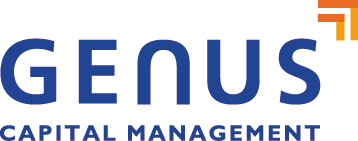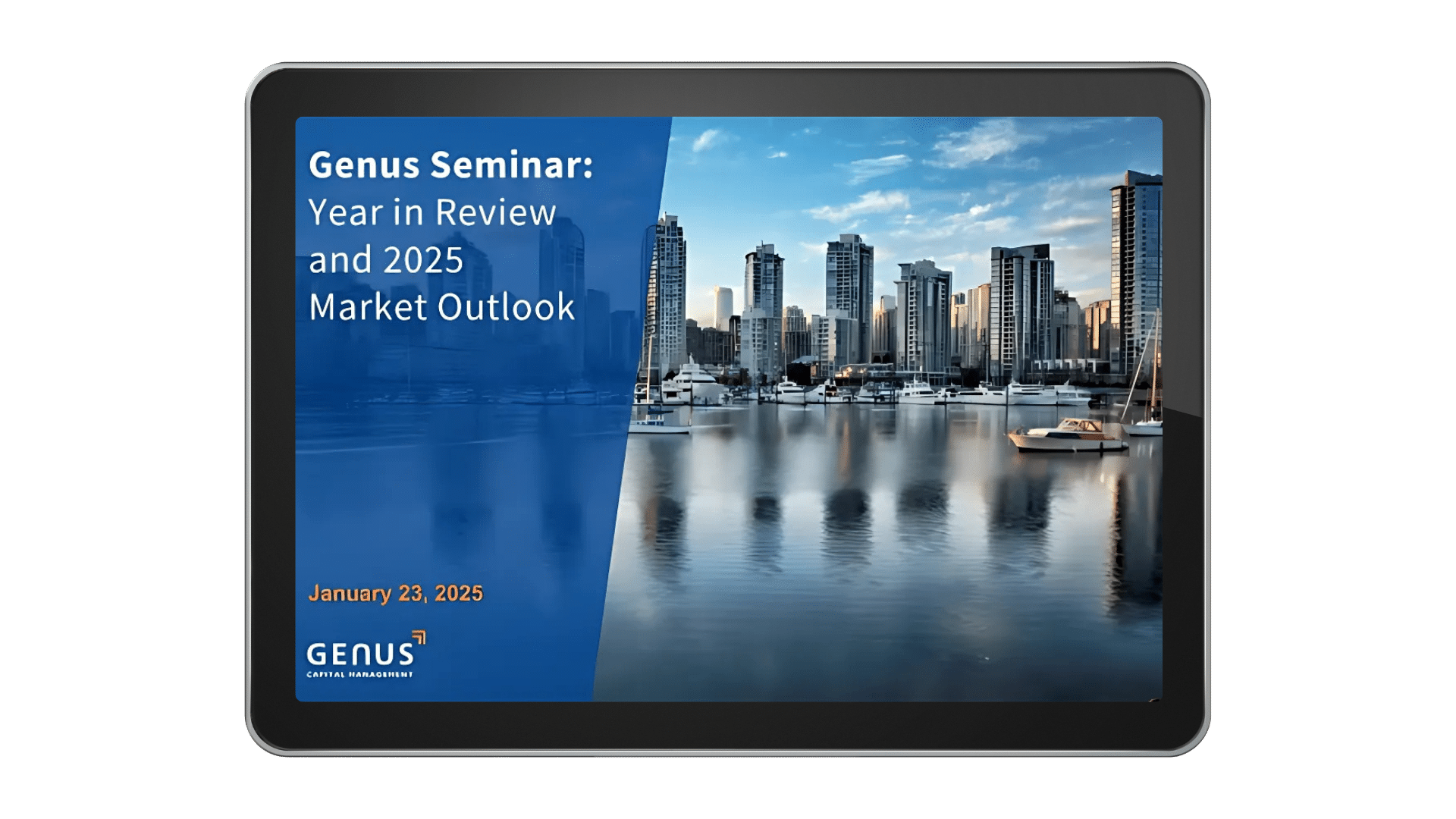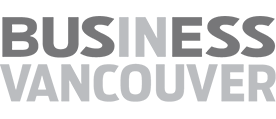Technology continues to be a big winner in this new Digital Era. Genus continues to make smart investments for positive portfolios; as well as plans for the future of a new digital economy.
Thomas Holloway: [00:00:03] Hello and welcome to the Genus weekly video. I’m a new face. My name is Tom Holloway and I recently joined the firm. I’m happy to be with you today and, Hi Wayne, thank you for joining us here.
Wayne Wachell: [00:00:15] Hi, Tom. Good to be here.
Thomas Holloway: [00:00:17] But here’s a fun one I just joined. But it turns out that Wayne already hired me once before back in 2006. I thought it might be a fun place to start contrasting hiring me back in 06 and then hiring me again this year.
Wayne Wachell: [00:00:30] Well, we discovered this bright young Ph.D. candidate at the University of Calgary about 17 years ago, and we brought him on to our onto our investment team, onto our bond team. He was helping us trade, helping the bond management. We ultimately we ended up outsourcing our bond process. And so he left us, went to another manager in town, a big manager in town, and ended up doing some work with Responsive on the robo side. And that’s where we we grabbed him again. So we had a sort of a technology theme, technology driven on the investment side. And he is important, very important to us, at least experience on the robo side. And we’re moving in that direction. He’s going to be a big part of that. So we’re glad to have him back in the fold.
Thomas Holloway: [00:01:23] Yeah, great. Nice to be back and to even be on the video. One of the layers that that Wayne and the team provide here at Genus is on asset mix. And what that means is switching between bonds and equity and cash. As we do every month. This week was the key rebalance month for balance week for asset mix. So why don’t you give us a little update Wayne on kind of what you’re buying, what you’re selling and where that leaves the portfolio?
Wayne Wachell: [00:01:50] Well, we made a bit of a shift this this this month, not a big shift. We shave some equities and put that put those proceeds back into spread product and corporate bonds and introduce macro fund, which has high yield and corporate bonds in the US. So we’re selling equities effectively and buying corporate bonds and high yield bonds. And interestingly enough, our our stock to bond signal stock to cash signal is is still very strong. Our bond to cash is kind of weak and our stock to bond signal is kind of neutral. And that usually causes us to do some some trades. We looked at the different signals and said, look, we’ve had a nice rally here. We’re at the top of the trading range. The range is between probably thirty three, thirty four hundred and twenty eight hundred. We think we’re getting close to the top. It’s been a nice range and we’re getting into the into the seasonal week period here in August, September, October, pre the election. And so we thought we would take some equity off the table. We did that for three percent, primarily from the dividend strategy, because we still see the cyclical side improving over the course of this year. And we don’t think the value value trades back in favor quite yet. Still more of a growth momentum type of tilt in within our portfolio. So that’s that’s that’s why we did so. Taking some off, some gone from equities into into a spread product, corporate corporate bonds and higher yield bonds effectively.
Thomas Holloway: [00:03:25] Ok, and in your answer there, I picked up on the way you talk about signals. So this isn’t just a trading range or a gut feel or something like that. The driver of this process is is this thing you call signals and, you know, let’s not get too technical, but maybe take us inside what you mean when you say signal?
Wayne Wachell: [00:03:44] Yeah, well, number one, we gather a bunch of macroeconomic data and we have about 30 different models that help us make asset mix shifts. We look at stocks versus bonds, stocks versus cash. How are corporate bonds doing compared to conventional bonds or government bonds, for example. We look at different regions and so it just helps us make decisions. At the end of the day, it’s up to us to make the call. We make the call charge here and and we use these models to help us make the decisions that we have more discipline around. We actually have back tested these models and see how they perform over the past twenty five, thirty years, through different cycles. They take into account valuation, take into account liquidity risk, the economic momentum, those kinds of things. We look at all the different eight different categories of fundamentals that go into all these different models, and they’re there to help us make our decisions.
Thomas Holloway: [00:04:38] And I think that’s a bit of a segway for me into today’s theme is technology. I want to ask a few questions about technology, starting with the portfolio itself. So inside the portfolio and inside the stock market right now, technology names are our huge focus. Those are the know the Netflix is of the world and Amazon and Apple. These are the biggest names in the market and some of the best performers as well. How do you think about those names?
Wayne Wachell: [00:05:03] And, yeah, they’ve done so well, they’re able to recover at some point in time, but they’ve done so well. They’ve been a big winner because the pandemic obviously that’s that’s accelerated the whole digital move to digital economy by probably three years, I’d say just to jump, start, jump, kick. And the bigger have gotten bigger and stronger and the weak are getting squeezed, obviously. And we’ve seen a move from moved from bricks and mortar to the technology side and going to be a big winner. And we’ve done, I think, a very good job of selecting the right names or picking the right names. We do have we have a pure technology stock selection model in the US that’s been the backbone of our stock models is really through a lot of our value and has come from it’s helped us pick those names and play the technology game very well. And it’s been a big winner. And we were we weren’t we didn’t have great exposure going into technology at the beginning of the year, but we rotated very strong and rapidly once we saw the effect of the pandemic and got the big idea that it was going to be a big boost for that for for technology and for the digital economy. And we’re seeing that in gangbusters here. And just it’s it’s a big, big it’s helped turn our fortunes around and get the performance we have this year.
Thomas Holloway: [00:06:17] Can you just talk a bit about so forget about Facebook and Netflix, but more like back home at Genus. How is I was Genus a technology firm when it comes to the portfolio side?
Wayne Wachell: [00:06:28] Well, back in the day when you started the firm, I would load up my Mac Macintosh into a bag and take it home for the weekend and start taking a diskettes and loading on my data and Macintosh to actually get all these runs working to rank our stocks over the weekend. It’s a very different proposition now. We have we have a team of a team of investment staff that they’re very educated. They have computational finance degrees. They have degrees in data science effectively. We have a strong computer computer team, computer science professionals that are is actually growing as the fastest growing part of our department of our firm actually is that department. We need more technology and they’ll need even so going forward, we need more and more help on that side there. So now we’re bringing in gigabits of data from around from around the world. But with big databases, we’re moving to the cloud. We want to move in. We have to move the cloud as the next big thing. We need more computational power, new, faster computers that can do more processing and reusing data from third party sources. We’re using third party models as well. There’s more value within it with our value chain, for example, and we’re pushing into AI. So it’s just it’s just it’s becoming more and more of a technology game to recognize that. And we have to lever our investment staff with good technology and help to make the right decisions. So about supporting decision making process for the investment team. And that’s what we want. That’s where technology comes into play. And I think especially it’s going to become more and more important as the market becomes just more efficient going forward in terms of understanding how you can slice and dice value versus growth. And I think good management, good managers are managing to get good performance will have to understand how to move from value to growth and back at the right time. And that’s where we’re moving to do more modeling, more research in that area, understand how the value trade works. We think we understand that that process and we’re doing more modeling and more research on that. I think the managers that don’t do that will be left behind.
Thomas Holloway: [00:08:37] What are some other ways in 30 years that you’ve seen the rest of the firm involved?
Wayne Wachell: [00:08:42] Well, we’re moving in those directions right now in terms of the plans we have on the boards right now. Number one is to is to work on an interface with clients where they can actually come in and look at their portfolios on a mobile app and a mobile app, for example, and and get everything like a robo advisory service on layered on top of that. Another area is our middle office. We’re looking at using more robots to help us reconcile and find areas and just a labor saving device, if you will. There’s a very simple robotic type rules that can help us manage a lot of these different issues in health efficiency and finally catch mistakes.
Thomas Holloway: [00:09:29] Yeah, great. Well, I think some of the quip on this is that every firm will become a technology firm. They just have a, you know, a bank logo on the door or or an ice cream logo on the door. But in the background, it’s basically a technology firm. Well, I think we’re going to sign off. And so thanks. Thanks so much for joining us. And thanks Wayne for your time, as always.
Wayne Wachell: [00:09:51] Thanks Tom.











